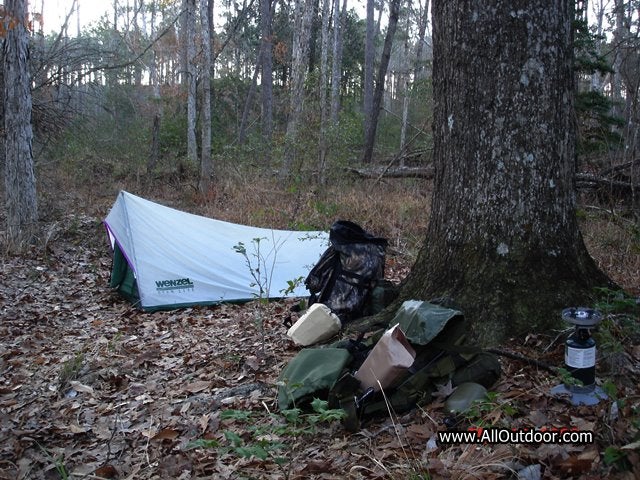What To Look For In a One Person Tent
Kevin Felts 03.14.18

As with everything else in life, the opinions expressed here will be subjective to different factors. Such as, this article was written from a southeast Texas climate point of view. Someone camping in the northern states may look for something different in a one person tent.
There are various factors that may impact selection. Is the person hiking, biking, boating or driving to the camp site? Obviously, someone who is hiking will be more concerned about weight than someone who is biking, boating or driving.
Let’s talk about some of the general factors that may impact tent selection.
This article focuses mainly on lightweight tents that would be used in the mild spring, summer and early fall months.
Size and Weight
One of the factors I look for in a one person tent is it will fit across the inside of my main backpacks. Take the large ALICE pack and the large MOLLE pack for example. Will the tent fit across the inside of the pack?
I have an unfounded fear of having the tent on the outside of the pack, and something like stickers poking a hole in it. Some of the stickers here in southeast Texas can grow to be an inch long. Something like that could tear a hole through the stuff sack and tent.
Weight is an obvious factor for hikers. There is an old saying, “Ounces equals pounds, pounds equal pain.”
Two of my one person tents:
- Wenzel Starlight: 2 pounds, 9.85 ounces.
- Eureka Solitaire: 2 pounds 9 ounces.
Single or Double Wall
Take the two above examples – Wenzel Starlight and the Eureka Solitaire.
On the Eureka Solitaire, the rain fly can be rolled back so the person can get ventilation during those hot summer months.
The Starlight on the other hand is a single wall tent. Single wall tents provide limited ventilation for summer months, and can also have condensation build up on the inside.
When using the Starlight, I take a rain poncho and build a shelter over the tent. This is for an extra layer of rain protection. The Solitaire on the other hand has a rain fly that does a pretty good job straight from the factory of keeping rain out.
Treating a single wall tent with a rain repellent is a double edged sword. Rain is kept out, and condensation from breathing (respiration) is kept in.
With a double wall tent, condensation from respiration is “supposed” to go through the mosquito net, collect on the rain fly, then drain down the rain fly. Some of the more expensive tents are supposed to let condensation out while preventing rain from coming in.
Free Standing
This means the tent is able to stand on its own without having to be staked down. What holds the tent up? The poles are designed in such a way that the poles hold the tent up.
Who would need a free standing tent? People who camp is rocky areas and/or unable to drive a stake in the ground.
One thing about free standing is you do not have to worry about them falling down in the middle of the night. It is aggravating to wake up in the middle of the night with the tent laying on top of the sleeping bag.
Final Thoughts
We could talk about other factors, such as:
- Double stitched seams. Help prevent the seams from tearing.
- Tub, which means the bottom of the tent folds up and prevents rainwater from entering the tent.
- Warranty.
- If the stitching is taped.
- Fiberglass VS metal tent poles. However, metal poles do not usually bend enough for a small one person tent. Fiberglass is more flexible than metal, but fiberglass can break.
- Materials.
- 3 or 4 seasons.
- Price.
With everything in life there is a trade off, and that goes for tents as well.
Question to the readers, what do you look for in a one person tent?
